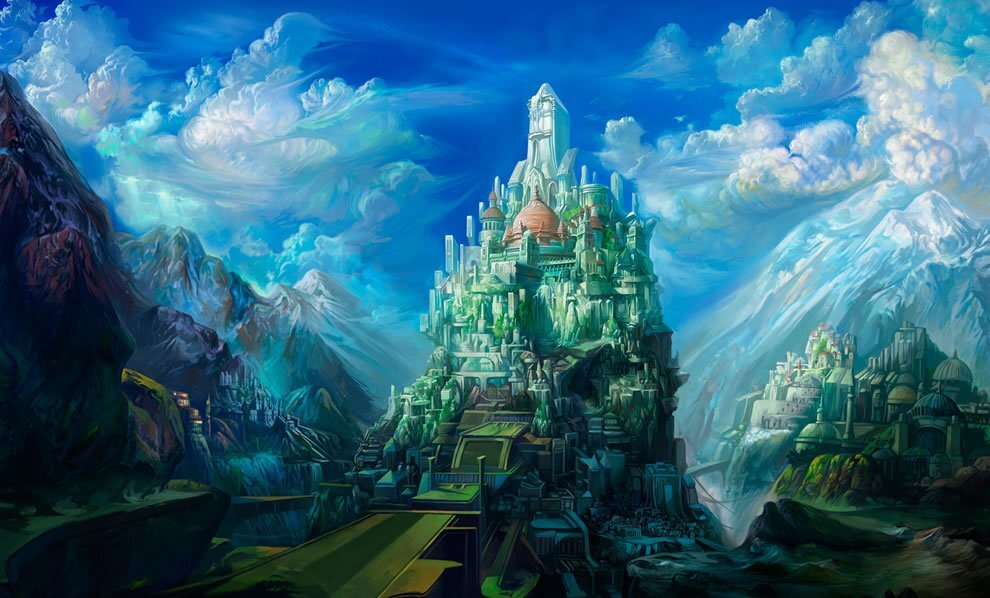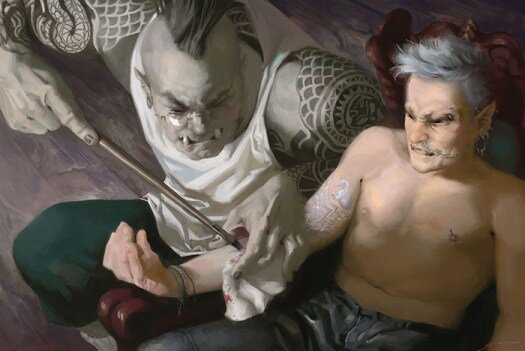The Basics of World Building: Setting the Tone
It’s a good idea to determine the overall atmosphere of your world. Every story you’ve ever read or watched on TV or played through in a video game has a setting that sets a tone for how much of a struggle it is to live and breathe in that world. This should be explained to the players right out the gate to ensure they know exactly what they’re getting into before they play, and you should decide on this so you can easily form your world around the themes you want to explore.
Consider Your World’s Alignment
Alignment in D&D 5e is not nearly as important as it was in older editions in regards to the player characters themselves. Your world’s alignment, however, unless it experiences an extraordinary and cataclysmic event, will remain stagnant throughout the players’ adventures. A world’s alignment can be imagined as the same nine block chart that you would see personal alignment. For player characters, alignment falls on a spectrum between four main aspects: law, chaos, evil, and good. For worlds, we’re working with different terms in the same orientation: nobleness, brightness, darkness, and grimness. This reddit post does a good job explaining these concepts with video game settings, but here’s some definitions:
Noble. Individual people can radically change the world with good deeds and heroics.
Bright. The world is full of opportunity, adventure, and light. It presents a fantastical place to seek out one’s fortune, reach one’s goals, and discover something new.
Dark. Individual people can do little to change the world. Good deeds and heroics, while perhaps making a small impact in the moment, cannot alone fix what’s, in many ways, broken.
Grim. The world is destitute and filled with treachery and deceit. It presents an intimidating and often miserable experience to those who try to conquer it, and exploring it only brings more and more suffering.
Neutral. Somewhere in between the four traits. There is no major lean toward one tone or the other.
In a block chart, you can combine the terms to have a general idea for how players should interpret your world. A Noblebright world is worth saving, and plenty of opportunity for the players to do so, with hope thriving even when evil rises to overtake it. A Grimdark story, by contrast, is overwhelmingly miserable and presents a likely impossible battle for the players to overcome, but makes actually overcoming those challenges more satisfying to some. In most cases, D&D worlds are somewhere in between; they have conflicts and life-threatening disasters that need to be solved, and the general public is often subject to these events without a way to solve them. However, the means to solve these problems exists, creating a Neutralbright/Neutraldark setting.
It’s good to have an idea for generally how your world feels, so you can build off that tone throughout the creation process. Is your world dark and full of horrors, or is it bright and full of opportunity? Can the heroes change the world, or are they just trying to survive in it?
Just like player alignment, remember that it’s a spectrum over a hard and fast rule. The chart is a point of reference, not an end-all-be-all, so don’t feel like you have to stay in a particular box. Instead, use it as a reference to work from.
Allow the World to Enhance Your Storytelling
Personally, I like the setting to highly cater to the story I’m telling. You can certainly create a neutral world that can be the host of all matters of stories, but trust me when I say that can cause some major tonal whiplash when your happy and sunny world suddenly plunges into a horrifying nightmare. It’s beneficial, as a result, to make a world where the story you want to tell is not only possible, but explainable and even inevitable. This prevents the disconnect the player can have if the story being told is bending over backwards to work in the world you set up. You don’t want to make a world that contradicts itself.
For example: if you are creating a super high-magic world (which D&D 5e leans heavily into) where nearly everyone has at least a little magical talent, you would have to work a little harder to explain why mundane problems - like a few wolves eating the livestock in a village - would be troublesome. If you’re creating a world where the Gods have heavy influence on the mortal realm, it’s going to be very odd if you drop in a plotline involving an atheist.
This isn’t to say these plotlines or quests can’t work, but that you would be making it harder than it needs to be by setting the world up one way but telling a story another way. It also allows the players to feel like they know about the world and can rely on that knowledge to help them. If your world changes too much too often, players will start to mistrust your word on certain lore.
Have the lore of your world support its creation. Is there an area of floating islands? Then your world likely has extra magic and technology that allows for easy flight. How did they get to this point? A disaster shot the islands into the sky and suspended them indefinitely. Think of ways the world and the lore can run parallel and lead into the story you want to tell.
What Story are You Telling?
Now that you’re thinking of the way things are, now consider the conflicts they can cause. This is a thought process you come up with near the end, in my opinion. While it works for people to come up with a story first, and then make the world around it, I do the opposite specifically for D&D games. Why? Because while you are the driving force as the Dungeon Master, you are only creating the foundation for the story, not the one truly telling it. You should always be willing to adjust your storytelling (to some extent) to the players and what they want to discover and experience. Coming up with a story too early on may make you instinctually rigid and uncompromising of your vision, which doesn’t bode well for a game that is largely shaped by the actions of the players. All that being said, it is your world. While minor adjustments should be made, and you should always make a story that is flexible for player tomfoolery, you also shouldn’t feel like you have to completely compromise what you enjoy writing. There should always be a balance - adjusting enough for player agency, but also having players who enjoy what you have created and are excited to dive into it.
So what story are you telling? Is it one where valiant heroes destroy a definitely evil overlord? Or, is it more morally grey, where anyone could be a villain or a hero from the right perspective? Is it a story of survival and that alone? The best way to decide is, based on the world you created, what is likely a story to be told. Based on what you made, what journey would occur with the conflicts that could arise?
In a world like Pokémon, while the protagonists are framed as taking on evil organizations and are particularly good at it, the world caters to the conflict of ‘bad people use the Pokémon for bad things’. It’s something you can see happening in that universe that definitely needs special people to solve. Conversely, you aren’t going to see too many fights for survival in the Pokémon universe, because that isn’t a conflict that makes sense based on what we know about the world. In Game of Thrones, on the other hand, you’re unlikely to see any of the characters merrily taking down bad guys, but the actual, political and bloody discourse that takes place in the universe makes sense based on how it’s set up.
In my personal homebrew, the world is highly magical and has many nasty creatures, but also a lot of people who can rise up to stop those creatures. It’s a balancing act of good and evil, but good and evil aren’t intensely cut and dry all the time. There are thriving gods and innovative mortals, so the stories I tell center around the conflicts that can arise from those factors.
If you base your stories off your world, you’ll find it much easier to narrow your focus and, in many cases, be able to implement sought after scenes and events you may have had unfinished, without a way to get to them.






